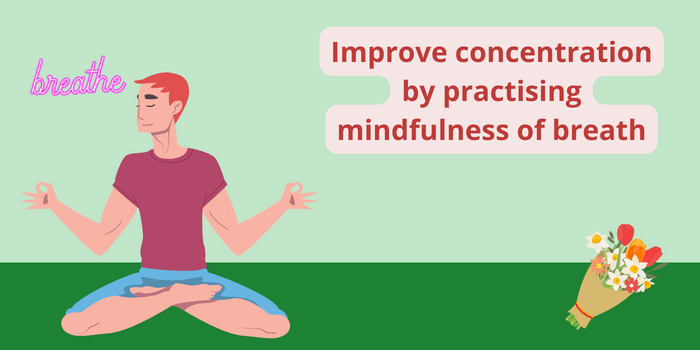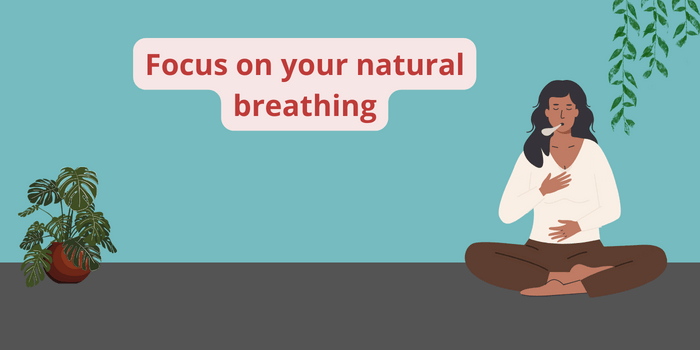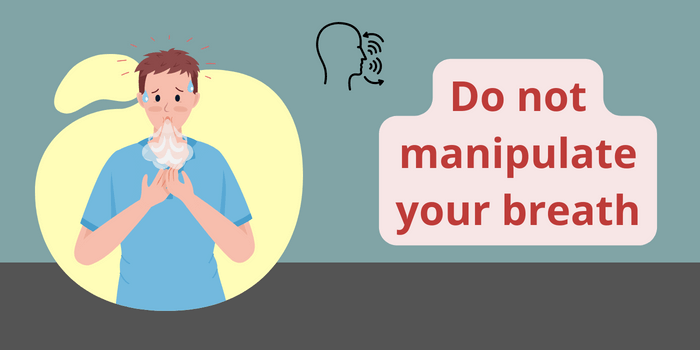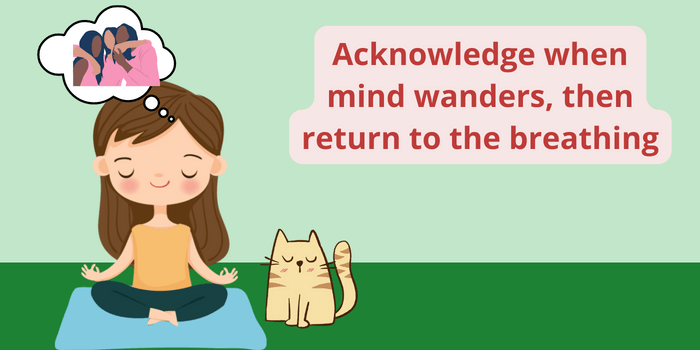Mindful breathing meditation has the simplest instructions of all types of meditation practices.
Just watch the flow of your breath as it enters and leaves the body. What could be simpler, right?
It may sound easy, but as you start practising, you will be surprised by how difficult it can be to stay focused on the breath.
The monkey mind jumps from one thought to the next relentlessly. But that’s the nature of the mind – to get distracted and constantly wander away. Your job is to bring it back to observing the breath.
When we begin meditating on the breath, we soon come to realize how unfocused we are. We live a life where there is so much stimuli to process, that we’re always in a state of continuous partial attention. We’re always automatically scanning the environment, and dividing our attention among different stimuli.
This splitting of attention lowers our ability to be in the present moment and keeps us in a persistently amped up mode of low grade stress.
Can you really pay full unbroken attention to anything for 10 minutes? Even 10 seconds is hard. Try it out and see for yourself.
Training in concentration
As we stay consistent with the practice, meditation can help us relax deeply and lead us to a realm of peace and tranquility. However, there is some foundational work that we need to do before we can get there.
The first step towards competence in meditation is to develop some degree of ability to totally focus on a single object. As you move to other techniques like vipassana, this concentration becomes a vital component that allows steady and even progress.
Some of us are more drawn towards emotionally engaging or heart-based practices of meditation, and may perceive mindfulness of breath as mechanical. Meet this mental resistance head on and devote sufficient time towards developing concentration through mindfulness of breathing.
Here, the only thing that we need to be concerned with is being mindful of the in-breath and the out-breath.
As you meditate, other thoughts and mental phenomena may arise. But whatever arises in the mind must simply be acknowledged before returning to observing the breathing. Just the simple inhalation and exhalation.
Do not interpret or dissect the thoughts and feelings that arise during mindfulness of breath meditation. Just stay single-mindedly focused on the experience of the breath and nothing more. This practice cultivates concentration and one-pointedness.
One-pointedness (ekaggatā in Pali) is what allows you to remain steadfast to one thing, without flitting from one thing to another like a grasshopper. With the ability to concentrate, you remain fully absorbed on the task and are capable of sustained endeavour.
This skill has wide-reaching applications on not just other types of meditation practices, but also in day to day tasks like preparing for an exam or immersing yourself deeply at work.
Why choose the breath to meditate on?
The breath itself has no special spiritual significance, it is just an easily accessible object that is always available to us to focus on. There is no esoteric symbolism here to entertain our minds with. We’re just paying attention to and closely feeling our regular ordinary breath.
We’re not considering breath to be our life-force, or that it is cleansing, or that we breathe in purity and breathe out impurities. We make no such assumptions here.
The breath is simply a religiously neutral, convenient, easily accessible, and portable object that is always available with us.
Don’t fall into the trap of attaching any special import to the breath. That will distract us from our true endeavour, which is to develop the skill of single-pointed concentration.
This foundational skill will help us as we get into more intensive meditation techniques later on.

Become A Morning Person Bootcamp
For calm mornings with a daily meditation & journaling routine
The technique
Let’s now get into the actual technique with a reminder that in mindfulness of breath meditation, the only concern is to concentrate on the in-breath and out-breath.
Go to your meditation spot which is away from the distractions of daily life. Set a timer for 10-20 minutes, as you wish.
Sit in a comfortable position with your spine erect, and hands resting gently on the lap. The posture should be relaxed so it allows you to stay comfortable but alert for the duration of the meditation.
Allow the face to relax, ease tension from your muscles, and let your gaze fall softly ahead. Now gently close your eyes.
We will meditate on the breath in two sections – purely focusing on the breath, and also counting after each breath. The slight alertness required for counting is helpful for beginners to stay focused, rather than have the mind wander away.
Section 1: Counting after each out-breath
We will start with the counting section.
Bring your attention to your breath, just the natural way you breathe, don’t force anything. Mentally count after each outbreath.
Breathe in, breathe out, count one…
Breathe in, breathe out, count two…
Breathe in, breathe out, count three…
Continue this counting till 10, and then go back up to 1 again.
If you lose the count in between, don’t worry, just start from 1 again.
Do this for roughly half the meditation session, and then move to section 2.
Section 2: Focus purely on the breath
In section 2, we focus purely on the breath, without counting.
Simply stay with the breath, as it flows in to the lungs and out of the body.
Breathe in… breathe out… breathe in… breathe out…
Every time the mind wanders, as it will, without any mental agitation or frustration, gently bring it back to the breath. Do this with great gentleness, patience, and kindness to yourself.
Continue focusing on the breath. Observe where it touches the nostrils. Observe the chest and belly rising and falling. Where all do you feel the breath? Explore with curiosity the body sensations accompanying the breath.
At the end of the session, as the timer goes off, gently open the eyes and sit still for a few moments collecting yourself. Try to hold onto some of the calm and focus from this session throughout the rest of your day.
As you go about your daily activities, it will also help to periodically pay attention to the breath.
Here is a 10 minute guided meditation video to get started.
Thinking about breathing vs awareness of breathing
As you practise connecting with the breath, many beginner meditators often encounter the problem of getting caught up in thinking about breathing and rather than the actual physical awareness of the breath.
But remember that your only mandate here is to observe the breathing itself, not ponder the idea of breathing.
Focus on the object, not the concept of the object.
The introduction of counting the breaths can help here – the extra deliberate attention that is required to stay aware of counting can keep the attention more on the breath.
Do not manipulate the breath
There are many meditation practices that require you to force your breath in a specific pattern. There are associated merits with those practices, but that’s not what we’re doing when we aim to simply connect with the breath.
As you practise, do not obstruct or hold the breath in any way. Do not try to breathe deeper or shallower than you normally would.
Do not forcibly inhale or exhale. This exercise is not about deep breathing.
We’re not observing the breath to cleanse or heal or purify or energize.
Put aside all previous ideas that you have heard about working with the breath. Just follow this process as though you have heard about something like this for the very first time.
In mindfulness of breath, we are simply observing the very ordinary activity of breathing and trying to improve our ability to keep our attention on it.
Are you breathing the right way?
This is also another place where beginner meditators get stuck. Am I breathing too shallow? Too deep? Too slow? Too fast? Should I breathe through the mouth or the nose? What if I have a cold?
The only advice that I have, which bears repeating is to allow your breath to be natural, as you would normally breathe.
If you feel lightheaded during meditation, it is usually an indication that you are manipulating your breath in some way. Do not hyperventilate or forcibly fill your lungs, instead just use your natural breath.
Sometimes as you get deep into meditation, the breath may become so shallow that you barely even perceive it.
You may even wonder if you are imagining the breath rather than actually observing it.
This wondering “about the breath” is also taking our focus away from actually “experiencing the breath”. So as soon as you become aware that you are thinking about whether the breath is too shallow, just acknowledge the thought, free your mind, and gently return to the observation.
If you are finding it difficult to feel the breath because it has become too shallow, just take a couple of deliberate deep breaths just to get back in touch with the physicality of breathing. This is a temporary remedy of getting in touch with the breath, to be used only if necessary. You may in fact never need to use it at all.
Dealing with mind wandering
Anyone who meditates, a novice or an experienced monk, will experience mind wandering because that is the nature of the mind. It will wander. Gradually, you will develop the ability to stay focused for longer and longer periods of time.
Your mind has been wandering as it pleased your entire life, so don’t expect it to stop just because you have started meditating.
The beauty of meditation is that you see the wandering, acknowledge it, and then return to the breathing.
Your mind may wander a hundred times or even a thousand. It does not matter, as long as you keep bringing it back to the breath.
The intensity of mind wandering may vary across meditation sessions – it’s completely natural. During some sessions you may experience great focus, and some sessions may feel like an exercise in futility because your mind will simply not be still. Both these extremes and everything in between are all part of the natural experience of meditation.
You’re getting in touch with reality, the way things are. Accept and embrace it.
The capacity to remember and wake up
Meditation is almost like remembering and reminding ourselves to wake up to the present moment.
You will notice this recurring cycle of waking up, being fully aware of the breath and the reality of your current experience, then forgetting and the mind wandering off somewhere.
How does this forgetting happen?
It could be by having too many thoughts, or memories, or even some creative solution popping up for a problem that you have been struggling with… it could be anything.
Then you remember, “oh yeah, I’m meditating” and bring your attention back. Inhale and exhale.
As you meditate, you are strengthening this ability to wake yourself up frequently.
When you are drifting off you are not aware of what’s happening, and there’s not much you can do about that. Except bring the attention back right when you become aware of the wandering.
As soon as you wake up from the wandering, remind yourself to focus your attention on the breath and what is happening at that moment. Experience that moment fully.
As you keep practising, you will develop the ability to stay present longer. You will start living in the present with more awareness, more consciousness, and less stress.
This is not to say that mind wandering is always bad, or that there is no place in our lives for creative thinking or planning or remembering things.
It’s just that all too often we are physically present somewhere, with our mind somewhere else. We could all do with less mind wandering, and more staying in the present moment to relish our life and the experiences that we have each moment.
Next: Working with thoughts
In the next article in this series, we will delve deeper into working with thoughts, feelings, and emotions.





